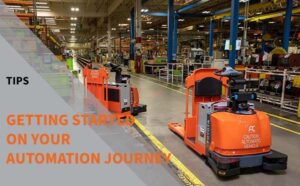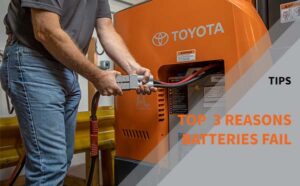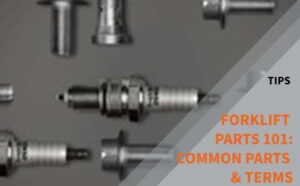
The three common enemies of drive and load wheels for warehouse products like Reach Trucks, Order Pickers, and Pallet Jacks are: heat, debris, and poor floor conditions. Here’s what you need to know about these enemies in order to decide on the best solution and overcome them in your unique operation.
Heat
Compression in these types of wheels creates heat. As the wheel rotates, the portion contacting the floor is compressed, and then when that part is no longer touching the floor, it expands back to its original shape. You can see an example of this by looking at the tires on your car. This expansion and contraction create heat. If this heat builds up enough, it creates cracks in the load wheel compound or causes the bond between the wheel compound and the wheel hub to release. As surprising as it may seem, this heat buildup even occurs in freezer applications.
Higher durometer compounds are the most common way to battle the heat. A higher durometer number means the wheel is “harder,” so it resists compression. Less compression equates to less heat. Trucks that move constantly generate more heat in the wheels, so they benefit from higher durometer wheels. The trade-off is that harder wheels have a rougher ride and usually cost more to purchase. The diameter of the wheel also plays a part in this heat equation. Larger diameter wheels do not have to spin as fast as smaller diameter wheels, so the compression cycle is not happening as often in a given distance. This is why drive tires can outlast load wheels on a given truck, even if they are the same compound.
Debris and Poor Floor Conditions
Debris exists in many customer operations as a by-product of the work environment. It may be due to poor housekeeping or due to a process that generates a lot of debris in the area where operators drive; but it is a load wheel killer. While debris can shorten the life of any forklift tire, load wheels tend to suffer the most.
Good housekeeping practices are the best form of eliminating load wheel damage from debris. Debris such as a piece of pallet stringer, or a rock from the outdoor yard, can keep the load wheel from turning. In the case of a forklift or pallet jack, though, there is a drive motor strong enough to keep the equipment moving while that load wheel slides along the floor. This creates a flat spot on the load wheel. If the debris is small enough for the load wheel to roll over, the heavy load on the forks often presses the debris into the load wheel material. Eventually, there isn’t enough space for both the debris and the load wheel compound, forcing the load wheel to come apart.
Good housekeeping is essential because even the smallest debris can seriously damage your wheels — regardless of its brand name or durometer.
Load Wheels
Load wheels are one of the most often overlooked aspects of warehousing products that can cause headaches when not configured correctly. The standard load wheel is frequently selected, assuming that it is a “one size fits all” solution. Understanding and using the correct load wheel for the application can significantly reduce your downtime and increase your productivity.
Reach Trucks:
As mentioned before, heat and debris are enemies of drive and load wheels. Reach trucks have the unique opportunity to increase the diameter of the load wheel. This reduces heat by reducing the number of rotations the wheel has to make over a given distance. The increased diameter also allows the wheel to roll over debris easier, reducing or eliminating the cause of flat spots. On the Toyota Reach Truck, there is an option for a 10-inch tall load wheel to accomplish this solution. Keep in mind that with such tall load wheels, you will need either wider baselegs to straddle the load or lift the loads up and over the load wheels to keep the pallets from coming in contact with them.
Pallet Trucks:
One type of wear unique to pallet trucks is “coning.” This is when the load wheels wear into a cone shape, usually with the edge closest to the outsides of the forks being the most worn. Frequent, tight turns can cause coning. This is especially noticeable when the floor surface is more abrasive. The best way to combat coning is to use load wheels that have been split into sections. This allows the outer portion of the load wheel to spin faster than the inner portion during a turn. This reduces the scuffing that causes cone-shaped wear. This is available as a triple load wheel on the Toyota Center-Controlled Rider, End-Controlled Rider, and Large Electric Walkie Pallet Jack. The Toyota Electric Walkie Pallet Jack is available as a dual load wheel.
Stand-Up Counterbalance Trucks:
These trucks do not have load wheels. They are included in this list because the steer wheels on these models can suffer from the same heat effects as load wheels do. On a Stand-Up Rider Forklift, the steer wheels carry the heavy counterweight when there is not a load on the forks to counterbalance. Customers who have light loads or frequent trips across the warehouse with empty forks can experience the same type of heat-related failures as a reach truck customer with load wheels. For this reason, the Stand-Up Counterbalance has steer wheel compounds ranging from a soft rubber to a hard polyurethane. The hard polyurethane tire will have a rougher ride but will not heat up as easily in applications that do a lot of driving with little to no weight on the forks.
Drive Wheels
Drive wheels (aka Drive Tires) deal with similar heat and debris issues as load wheels, with the addition of needing to provide traction for acceleration, braking, and steering. When needing to find the best fit for an application, this makes the trade-off into a three-way consideration, instead of the two-way consideration of the load wheel. Generally speaking, traction takes priority of the three factors. Floor conditions will play a big role in determining how much of a priority traction takes.
Drive wheels may have to function on smooth floors with moisture or dust making traction difficult. The floor may be abrasive, providing high traction, but also increasing wear on the tire. There may be ice on the floor, but in a food environment where a metal-studded tire would not be acceptable. In order to provide the best possible solution for the customer, a variety of drive tires are offered. The below list describes a few of the available options, but there are more types available through factory installation and aftermarket sales.
Drive Wheel Type
Rubber Wheels
Pros: Smooth ride, good traction on a variety of floors.
Cons: Soft compound means easier heat buildup in applications that are always moving.
Smooth Polyurethane Wheels (Varying durometers and compounds)
Pros: Non-marking, various compounds allow for a customized balance of ride quality vs heat resistance.
Cons: Requires better floor conditions for traction. Smooth, dry floors or mildly abrasive floors are best.
Siped-Polyurethane Wheels (Smooth polyurethane tire that has diagonal razor cuts in the traction surface)
Pros: Provides better traction in slippery conditions than a smooth poly tire, while retaining heat resistance benefits.
Cons: Razor cuts in the poly material reduce the tire’s life if driven on a dry or abrasive floor. Potential reduction in traction on smooth, dry floors due to reduced surface area.
Selecting the right tire compound for your forklift and application doesn’t need to be a hassle. A free site consultation from your local Toyota dealer can help to confirm the tire type and size that best fits your specific needs. If your current tire setup is less than optimal, they can also help to order replacement load wheels and drive wheels to get you back on track and work as productively and efficiently as possible.


